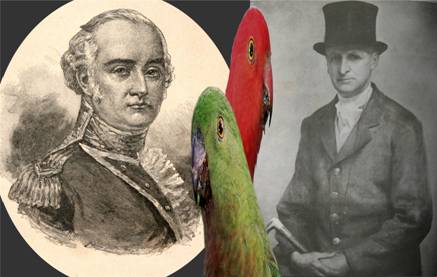A much better performance. Ian Fraser got it in 10 minutes,
and Anthony O was just about there. All other entries had correct
elements, and made up for the missing elements by exposing lateral thinking or an
original approach. Here is a small version of the picture again:

I took the precaution of writing the answer beforehand so I
would not be overborne or intimidated. Here it is:
Captain Philip Gidley King RN (1758-1808), third governor of
NSW, 1800-1806, and Gregory Macalister Mathews CBE (1876-1949), the latter from
a portrait in oils in his 53rd year. In 1939 Mathews donated
his large ornithological book collection to the National Library, where it is
available to be consulted by the more bookish Canberra birdwatcher.
The King Parrot (the stretched sub-species A scapularis
elongatus shown here) is named for Governor King. George Caley, a
botanist engaged by Joseph Banks, came to Sydney in 1800 on the same ship as
the returning King, and for the next 10 years collected many Australian bird
specimens. He called one of the local birds ‘King’s
Parrot’ and that was the name used in his notes that were quoted by
Vigors and Horsfield in their presentation to the Linnean Society in June
1825. However the “ ‘s” was soon dropped. In a
discussion at the society in March 1825 about another bird named for King it
was noted that ‘the bird commonly called the King Parrot was also
originally called King’s Parrot after the same
gentleman’. 153 years later, in 1978, an RAOU panel decided
that a good name for this species would be ‘Australian King-Parrot’
and that remains the English name recommended by that organisation and used by
COG. However the effect is to obscure the origin of the name and lead to
a common assumption that the bird has some king-like quality.
Gregory Mathews was an industrious name-inventor. In
1911 he decided the King Parrot (as it then was) needed to be in a new genus
rather than the same one as the Red-winged Parrot so he called the new genus Alisterus
for his 4-year-old son Alister William Mathews. So the two men each had a
significant role in determining what we call (or don’t call) the King
Parrot.
Incidentally, not directly related to the question, the
nesting habits of the King Parrot are not well-known and there is uncertainty
over whether it ever breeds in the Canberra area. (There is an article by
Chris Davey in CBN in 2002, and a follow-up note by Michael Lenz in
2003.) Gould, who called it a ‘King Lory’, was unable to
‘gather any information respecting this part of the bird’s
economy’. He added: ‘I am inclined to look with
suspicion on the account of its breeding given by Mr Caley in the Linnean
Transactions: in my opinion it must have reference to some other
bird’. Must have been those 12 speckled eggs that worried him.

